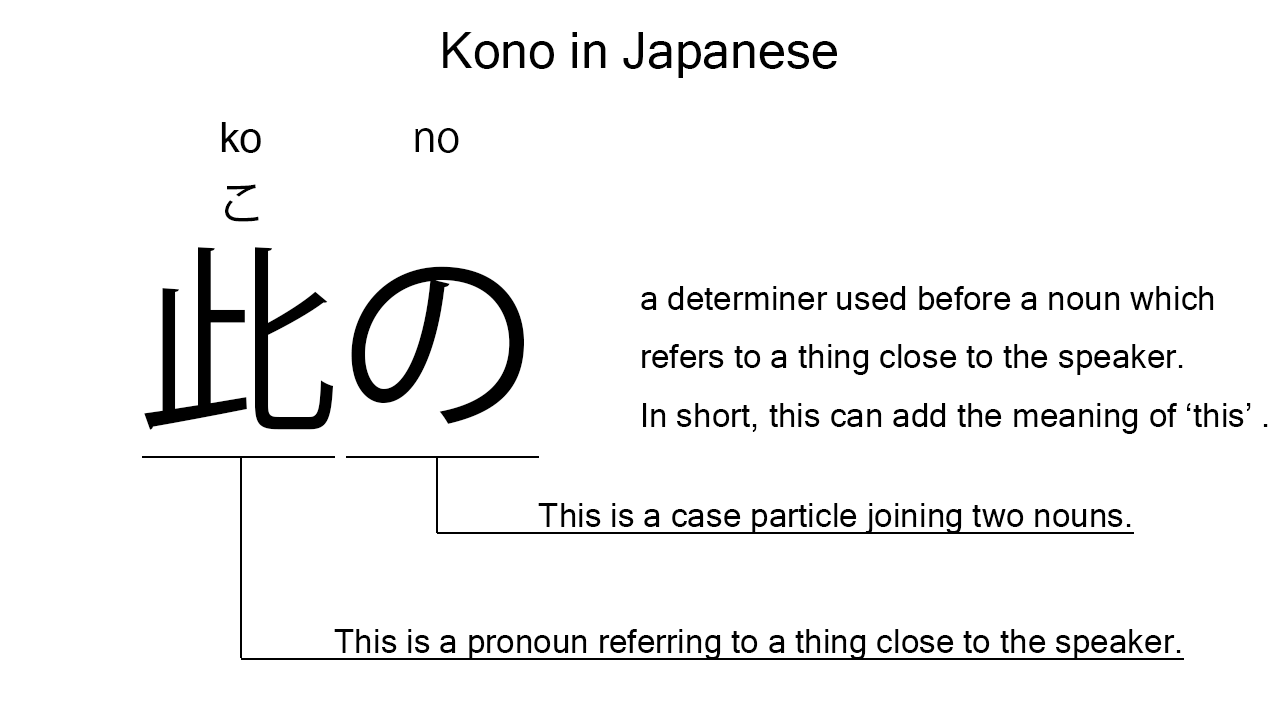What does “kono” mean in Japanese?
Native speakers often use “kono” as a determiner to add the meaning of ‘this’ in Japanese. Perhaps, some Japanese learners know this word as it is sometimes used in Japanese conversations. In this blog post, however, I will explain this word in detail together with its kanji expression. And also, I will explain how to use it through example sentences. My explanations would help Japanese learners understand “kono” more clearly. Then, let’s get started!
Contents
Definition and meaning of “kono”
Let me start with the definition and meaning of “kono”.
- kono – この : a determiner used in front of a noun which refers to a thing close to the speaker.
Japanese native speakers normally use this determiner in front of a noun to refer to a thing close to them. Its role is very similar to that of the English determiner, “this”, I think.
This determiner is basically written in hiragana, but can be written in kanji too. Interestingly, its kanji expression helps us understand the concept more clearly, so let me explain it in detail.
Kono in kanji
The kanji expression of “kono” consists of the following two characters:
- 此 : a kanji character used as a pronoun to refer to a thing close to the speaker.
- の : a case particle joining two nouns or noun equivalent words. Normally, the first one can work as a modifier to describe the second. In this case, this works after “ko” to change it to a modifier which means ‘this’ in Japanese.
These two characters tell us that the formed determiner literally means ‘this’ in Japanese. This literal interpretation is completely in line with the actual meaning and role.

So far, I’ve explained the definition and meaning of “kono” together with its kanji expression. Then, let me explain how to use it through the example sentences below.
Example #1: how to use “kono”
kono shashin wo kanojo ni mise tai – この写真を彼女に見せたい (このしゃしんをかのじょにみせたい)
I want to show her this photo.
Below are the new words used in the example sentence.
- shashin – 写真 (しゃしん) : a noun meaning ‘photo’ in Japanese. This can also work as plural. Learn more about Japanese plural.
- wo – を : a case particle used to make the object word in a sentence. In the example, this is used after “kono shashin” to make the object in the sentence.
- kanojo – 彼女 (かのじょ) : a pronoun meaning ‘she’ in Japanese.
- ni – に : a case particle used to say in which direction an action goes. In the example, this is used after “kanojo” to say to whom the speaker wants to show the photo.
- mise – 見せ (みせ) : one conjugation of the verb, “miseru“, which means ‘to show’ in Japanese. In the example, it has been conjugated for the better connection with its following word.
- tai – たい : an auxiliary verb used after a verb to make its desire form. Probably, this is well known as a part of Japanese tai form. In the example, this is used after “mise” to make its desire form, “mise tai”, which means ‘to want to show’ in Japanese.
This is a typical usage of “kono”. In this example, it works in front of the noun, “shashin”, to say “this photo” in Japanese.
Example #2: another usage of “kono”
watashi wa kono himawari ga suki desu – 私はこの向日葵が好きです (わたしはこのひまわりがすきです)
I love this sunflower.
Below are the new words used in the example sentence.
- watashi – 私 (わたし) : a pronoun meaning ‘I’ in Japanese.
- wa – は : a binding particle working as a case marker or topic marker. In the example, this works after “watashi” to make the subject in the sentence.
- himawari – 向日葵 (ひまわり) : a noun meaning ‘sunflower’ in Japanese. This can also work as plural.
- ga – が : a case particle used to make the subject word or the object word in a sentence. In the example, this is used after “himawari” to make the object in the sentence.
- suki – 好き (すき) : the stem part of the na-adjective, “sukina”, which means ‘favorite’ in Japanese. Native speakers, however, often use this as an individual word to mean ‘to like’ or ‘to love’ in Japanese. In the example, this is used to mean ‘to love’.
- desu – です : an auxiliary verb used after a noun or adjective to make it polite. Probably, this is well known as a part of Japanese desu form. In the example, this is used after “suki” to make it sound polite.
This is another typical usage of “kono”. In this example, it works in front of the noun, “himawari”, to say “this sunflower” in Japanese. When we want to use a determiner to add the meaning of ‘this’ in Japanese, “kono” is always a very good option.
Summary
In this blog post, I’ve explained the definition and meaning of “kono” in detail together with its kanji expression. And also, I’ve explained how to use it through the example sentences. Let me summarize them as follows.
- kono – この : a determiner used in front of a noun which refers to a thing close to the speaker. Native speakers normally use this determiner in front of a noun to add the meaning of ‘this’ in Japanese. The role is very similar to that of the English determiner, “this”, I think. This is basically written in hiragana, but can be written in kanji too. The kanji expression is “此の”. The first character is a pronoun which refers to a thing close to the speaker; the second is a case particle which changes its preceding word to a modifier. So, the kanji expression is literally a determiner which means ‘this’ in Japanese.
Hope my explanations are understandable and helpful for Japanese learners.